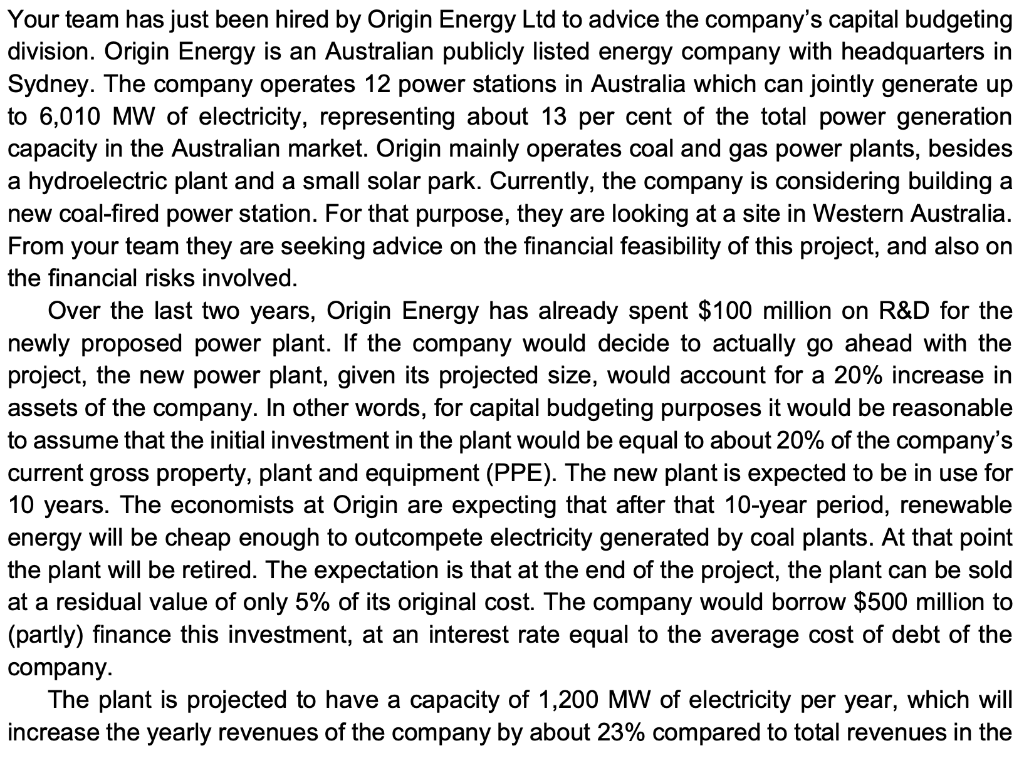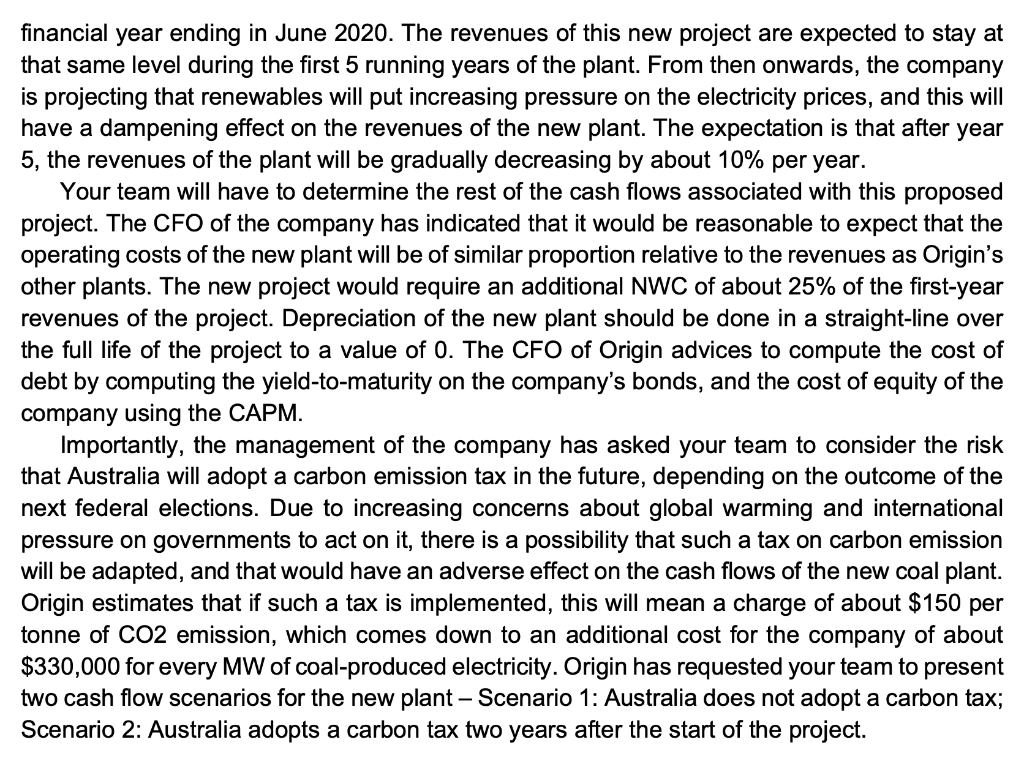Answered step by step
Verified Expert Solution
Question
1 Approved Answer
Question: Provide clear advice on whether or not the company should go ahead with the projected power plant and the advice of your team based


Question: Provide clear advice on whether or not the company should go ahead with the projected power plant and the advice of your team based on your estimations of the NPV and the IRR of the proposed project under the two different possible scenarios. (Your results will have to be supported by clear tables which show the calculation of the free cash flows; clear explanations of how the free cash flows were computed, and what choices were made in these computations, and why.)
Your team has just been hired by Origin Energy Ltd to advice the company's capital budgeting division. Origin Energy is an Australian publicly listed energy company with headquarters in Sydney. The company operates 12 power stations in Australia which can jointly generate up to 6,010 MW of electricity, representing about 13 per cent of the total power generation capacity in the Australian market. Origin mainly operates coal and gas power plants, besides a hydroelectric plant and a small solar park. Currently, the company is considering building a new coal-fired power station. For that purpose, they are looking at a site in Western Australia. From your team they are seeking advice on the financial feasibility of this project, and also on the financial risks involved. Over the last two years, Origin Energy has already spent $100 million on R&D for the newly proposed power plant. If the company would decide to actually go ahead with the project, the new power plant, given its projected size, would account for a 20% increase in assets of the company. In other words, for capital budgeting purposes it would be reasonable to assume that the initial investment in the plant would be equal to about 20% of the company's current gross property, plant and equipment (PPE). The new plant is expected to be in use for 10 years. The economists at Origin are expecting that after that 10-year period, renewable energy will be cheap enough to outcompete electricity generated by coal plants. At that point the plant will be retired. The expectation is that at the end of the project, the plant can be sold at a residual value of only 5% of its original cost. The company would borrow $500 million to (partly) finance this investment, at an interest rate equal to the average cost of debt of the company. The plant is projected to have a capacity of 1,200 MW of electricity per year, which will increase the yearly revenues of the company by about 23% compared to total revenues in the financial year ending in June 2020. The revenues of this new project are expected to stay at that same level during the first 5 running years of the plant. From then onwards, the company is projecting that renewables will put increasing pressure on the electricity prices, and this will have a dampening effect on the revenues of the new plant. The expectation is that after year 5, the revenues of the plant will be gradually decreasing by about 10% per year. Your team will have to determine the rest of the cash flows associated with this proposed project. The CFO of the company has indicated that it would be reasonable to expect that the operating costs of the new plant will be of similar proportion relative to the revenues as Origin's other plants. The new project would require an additional NWC of about 25% of the first-year revenues of the project. Depreciation of the new plant should be done in a straight-line over the full life of the project to a value of 0. The CFO of Origin advices to compute the cost of debt by computing the yield-to-maturity on the company's bonds, and the cost of equity of the company using the CAPM. Importantly, the management of the company has asked your team to consider the risk that Australia will adopt a carbon emission tax in the future, depending on the outcome of the next federal elections. Due to increasing concerns about global warming and international pressure on governments to act on it, there is a possibility that such a tax on carbon emission will be adapted, and that would have an adverse effect on the cash flows of the new coal plant. Origin estimates that if such a tax is implemented, this will mean a charge of about $150 per tonne of CO2 emission, which comes down to an additional cost for the company of about $330,000 for every MW of coal-produced electricity. Origin has requested your team to present two cash flow scenarios for the new plant - Scenario 1: Australia does not adopt a carbon tax; Scenario 2: Australia adopts a carbon tax two years after the start of the project. Your team has just been hired by Origin Energy Ltd to advice the company's capital budgeting division. Origin Energy is an Australian publicly listed energy company with headquarters in Sydney. The company operates 12 power stations in Australia which can jointly generate up to 6,010 MW of electricity, representing about 13 per cent of the total power generation capacity in the Australian market. Origin mainly operates coal and gas power plants, besides a hydroelectric plant and a small solar park. Currently, the company is considering building a new coal-fired power station. For that purpose, they are looking at a site in Western Australia. From your team they are seeking advice on the financial feasibility of this project, and also on the financial risks involved. Over the last two years, Origin Energy has already spent $100 million on R&D for the newly proposed power plant. If the company would decide to actually go ahead with the project, the new power plant, given its projected size, would account for a 20% increase in assets of the company. In other words, for capital budgeting purposes it would be reasonable to assume that the initial investment in the plant would be equal to about 20% of the company's current gross property, plant and equipment (PPE). The new plant is expected to be in use for 10 years. The economists at Origin are expecting that after that 10-year period, renewable energy will be cheap enough to outcompete electricity generated by coal plants. At that point the plant will be retired. The expectation is that at the end of the project, the plant can be sold at a residual value of only 5% of its original cost. The company would borrow $500 million to (partly) finance this investment, at an interest rate equal to the average cost of debt of the company. The plant is projected to have a capacity of 1,200 MW of electricity per year, which will increase the yearly revenues of the company by about 23% compared to total revenues in the financial year ending in June 2020. The revenues of this new project are expected to stay at that same level during the first 5 running years of the plant. From then onwards, the company is projecting that renewables will put increasing pressure on the electricity prices, and this will have a dampening effect on the revenues of the new plant. The expectation is that after year 5, the revenues of the plant will be gradually decreasing by about 10% per year. Your team will have to determine the rest of the cash flows associated with this proposed project. The CFO of the company has indicated that it would be reasonable to expect that the operating costs of the new plant will be of similar proportion relative to the revenues as Origin's other plants. The new project would require an additional NWC of about 25% of the first-year revenues of the project. Depreciation of the new plant should be done in a straight-line over the full life of the project to a value of 0. The CFO of Origin advices to compute the cost of debt by computing the yield-to-maturity on the company's bonds, and the cost of equity of the company using the CAPM. Importantly, the management of the company has asked your team to consider the risk that Australia will adopt a carbon emission tax in the future, depending on the outcome of the next federal elections. Due to increasing concerns about global warming and international pressure on governments to act on it, there is a possibility that such a tax on carbon emission will be adapted, and that would have an adverse effect on the cash flows of the new coal plant. Origin estimates that if such a tax is implemented, this will mean a charge of about $150 per tonne of CO2 emission, which comes down to an additional cost for the company of about $330,000 for every MW of coal-produced electricity. Origin has requested your team to present two cash flow scenarios for the new plant - Scenario 1: Australia does not adopt a carbon tax; Scenario 2: Australia adopts a carbon tax two years after the start of the projectStep by Step Solution
There are 3 Steps involved in it
Step: 1

Get Instant Access to Expert-Tailored Solutions
See step-by-step solutions with expert insights and AI powered tools for academic success
Step: 2

Step: 3

Ace Your Homework with AI
Get the answers you need in no time with our AI-driven, step-by-step assistance
Get Started


